《安娜卡列尼娜》英文
- 格式:ppt
- 大小:964.50 KB
- 文档页数:17
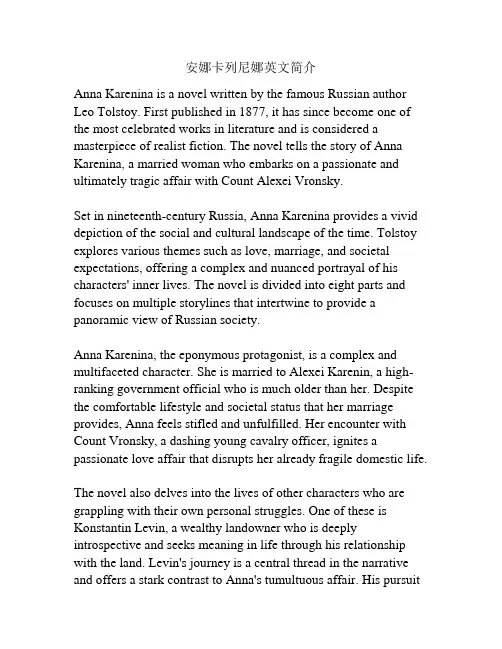
安娜卡列尼娜英文简介Anna Karenina is a novel written by the famous Russian author Leo Tolstoy. First published in 1877, it has since become one of the most celebrated works in literature and is considered a masterpiece of realist fiction. The novel tells the story of Anna Karenina, a married woman who embarks on a passionate and ultimately tragic affair with Count Alexei Vronsky.Set in nineteenth-century Russia, Anna Karenina provides a vivid depiction of the social and cultural landscape of the time. Tolstoy explores various themes such as love, marriage, and societal expectations, offering a complex and nuanced portrayal of his characters' inner lives. The novel is divided into eight parts and focuses on multiple storylines that intertwine to provide a panoramic view of Russian society.Anna Karenina, the eponymous protagonist, is a complex and multifaceted character. She is married to Alexei Karenin, a high-ranking government official who is much older than her. Despite the comfortable lifestyle and societal status that her marriage provides, Anna feels stifled and unfulfilled. Her encounter with Count Vronsky, a dashing young cavalry officer, ignites a passionate love affair that disrupts her already fragile domestic life. The novel also delves into the lives of other characters who are grappling with their own personal struggles. One of these is Konstantin Levin, a wealthy landowner who is deeply introspective and seeks meaning in life through his relationship with the land. Levin's journey is a central thread in the narrative and offers a stark contrast to Anna's tumultuous affair. His pursuitof happiness and his struggle with faith and identity are themes that resonate throughout the novel.Tolstoy expertly weaves together the various plotlines, providing a rich tapestry of interconnected stories. Through his vivid and detailed descriptions, he brings nineteenth-century Russia to life, immersing the reader in a world of opulent ballrooms, rural countryside, and high society. The author's keen observations of human nature and his ability to capture the intricacies of human emotions are on full display in Anna Karenina.The novel also offers a critique of the social norms and conventions of the time. Tolstoy raises questions about the institution of marriage, the role of women in society, and the impact of societal expectations on individual happiness. Through Anna's story, he explores the double standards and hypocrisy prevalent in Russian high society, where men are given more leeway in pursuing extramarital affairs while women face social ostracism and abandonment.Anna Karenina is not only a character-driven novel but also a reflection on the human condition. Tolstoy delves into the complexities of love, desire, and passion, examining the consequences of choices made in the pursuit of personal happiness. The novel presents a nuanced exploration of the human psyche, delving into the depths of human nature, and offering insights into the complexities of the human heart.Brimming with richly drawn characters, intricate plotlines, and profound philosophical musings, Anna Karenina remains a literarymasterpiece that continues to captivate readers to this day.Tolstoy's exploration of love, desire, and societal expectations transcends time and place, making Anna Karenina a timeless classic. It is a novel that invites contemplation on the complexitiesof human relationships and the universal longing for happiness and fulfillment.标题:食品浪费问题以及解决方案导言:随着全球人口的不断增长和经济的发展,食品浪费问题日益严重。
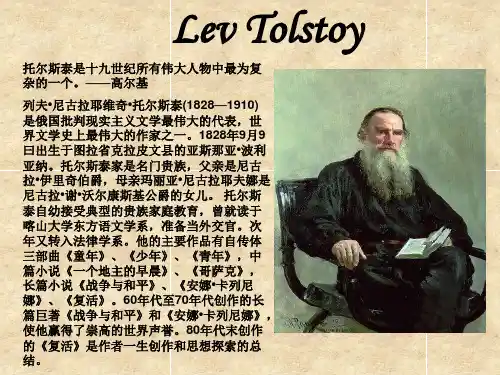
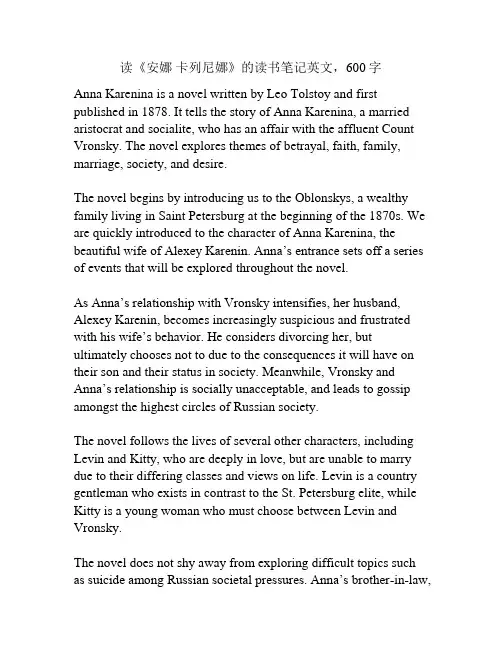
读《安娜卡列尼娜》的读书笔记英文,600字Anna Karenina is a novel written by Leo Tolstoy and first published in 1878. It tells the story of Anna Karenina, a married aristocrat and socialite, who has an affair with the affluent Count Vronsky. The novel explores themes of betrayal, faith, family, marriage, society, and desire.The novel begins by introducing us to the Oblonskys, a wealthy family living in Saint Petersburg at the beginning of the 1870s. We are quickly introduced to the character of Anna Karenina, the beauti ful wife of Alexey Karenin. Anna’s entrance sets off a series of events that will be explored throughout the novel.As Anna’s relationship with Vronsky intensifies, her husband, Alexey Karenin, becomes increasingly suspicious and frustrated with his wife’s behavior. He considers divorcing her, but ultimately chooses not to due to the consequences it will have on their son and their status in society. Meanwhile, Vronsky and Anna’s relationship is socially unacceptable, and leads to gossip amongst the highest circles of Russian society.The novel follows the lives of several other characters, including Levin and Kitty, who are deeply in love, but are unable to marry due to their differing classes and views on life. Levin is a country gentleman who exists in contrast to the St. Petersburg elite, while Kitty is a young woman who must choose between Levin and Vronsky.The novel does not shy away from exploring difficult topics such as suicide among Russian societal pressures. Anna’s brother-in-law,Stepan, is also shown to commit suicide due to his frustration and disappointment with society.Ultimately, Anna chooses to leave her family and society behind and follow her heart, leading to her death. Her death serves as a dramatic finale to the novel and symbolizes the tragedy that follows unfaithfulness.Anna Karenina is a powerful exploration of love, morality, and the oppression of society on individuals. It serves as a stark reminderof the consequences of going against social norms and proves that even the most complex emotions can be explored through literature.。
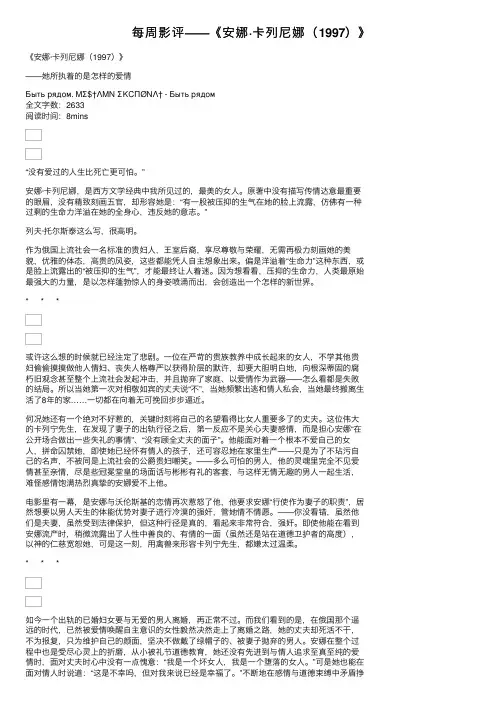
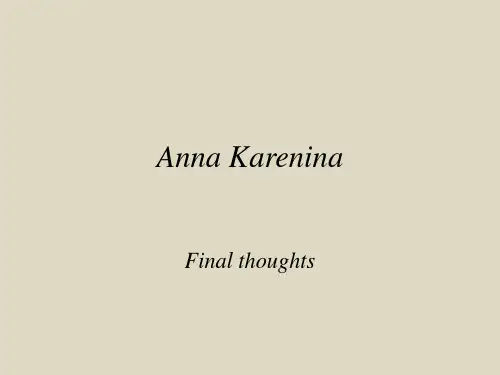
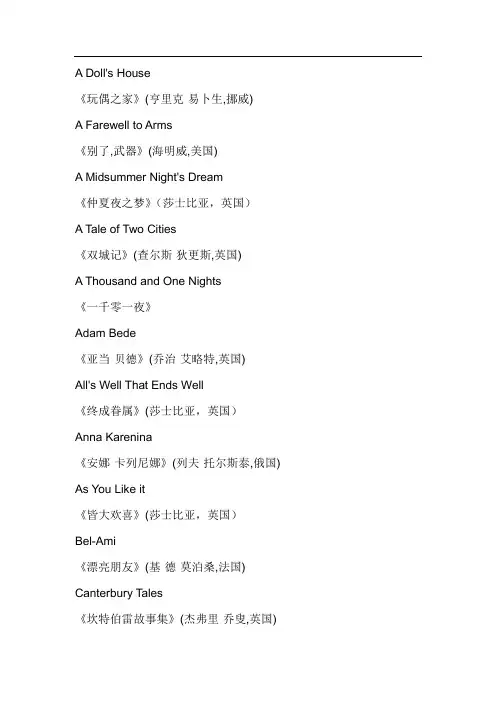
A Doll's House《玩偶之家》(亨里克·易卜生,挪威)A Farewell to Arms《别了,武器》(海明威,美国)A Midsummer Night's Dream《仲夏夜之梦》(莎士比亚,英国)A Tale of Two Cities《双城记》(查尔斯·狄更斯,英国)A Thousand and One Nights《一千零一夜》Adam Bede《亚当·贝德》(乔治·艾略特,英国)All's Well That Ends Well《终成眷属》(莎士比亚,英国)Anna Karenina《安娜·卡列尼娜》(列夫·托尔斯泰,俄国) As You Like it《皆大欢喜》(莎士比亚,英国)Bel-Ami《漂亮朋友》(基·德·莫泊桑,法国) Canterbury Tales《坎特伯雷故事集》(杰弗里·乔叟,英国)Childe Harold's Pilgrimage《查尔德·哈罗德游记》(拜伦,英国) Crime and Punishment《罪与罚》(陀斯妥也夫斯基,俄国〕David Copperfield《大卫·科波菲尔》(查尔斯·狄更斯,英国) Don Juan《唐璜》(乔治·戈登·拜伦,英国)Elegy Written in a Country Churchyard 《墓地衰歌》(托马斯·格雷,英国) Emma《爱玛》(简·奥斯汀,英国)Essays《培根论说文集》(弗郎西斯·培根,英国) Fairy Tales《安徒生童话》(安徒生,丹麦)For Whom the Bell Tolls《丧钟为谁而鸣》(海明威,美国)Gone with the Wind《乱世佳人》/《飘》Good Wives《好妻子》(露易莎·梅·奥尔科特,美国)Great Expectations《远大前程》(查尔斯·狄更斯,英国) Gulliver's Travels《格利佛游记》(乔纳森·斯威福特,英国) Hamlet《哈姆雷特》(莎士比亚,英国)Jane Eyre《简·爱》(夏洛特·勃朗特,英国)Jean-Christophe(《约翰·克利斯朵夫》(罗曼·罗兰,法国) King Lear《李尔王》(莎士比亚,英国)Lady Chatterlay's Lover《查太莱夫人的情人》(劳伦斯,英国) Les Miserables《悲惨世界》(雨果,法国)Little Women《小妇人》(露易莎·梅·奥尔科特,美国) Love of Life《热爱生命》(杰克.伦敦,美国) Mansfiela Park《曼斯菲尔德庄园》(简·奥斯汀,英国)Measure for Measure《自作自受》(莎士比亚,英国)Moby Dick《大白鲨》(赫尔曼·梅尔维尔,美国)Mrs. Warren's Profession《沃伦夫人的职业》(乔治·伯纳德·肖,英国) Much ado about Nothing《无事生非》(莎士比亚,英国)Nature《自然》(拉尔夫·沃尔多·爱默生,美国) Ode to a Nightingale《夜莺颂》(约翰·济慈,英国)Ode to the West Wind《西风颂》(雪莱,英国)Of Studies《论学习》(弗郎西斯·培根,英国)Oliver Twist《雾都孤儿》(查尔斯·狄更斯,英国) Othello《奥赛罗》(莎士比亚,英国)Paradise Lost《失乐园》(约翰·弥尔顿,英国)Persuasion《劝说》(简·奥斯汀,英国)Pride and Prejudice《傲慢与偏见》(简·奥斯汀,英国) Prometheus Unbound《被释的普罗米修斯》(雪莱,英国) Resurrection《复活》(列夫·托尔斯泰,俄国)Rob Roy《罗伯·罗伊》(沃尔特·斯科特,英国) Robinson Crusoe《鲁滨逊飘流记》(丹尼尔·笛福,英国) Romeo and Juliet《罗密欧与朱丽叶》(莎士比亚,英国)Sense and Sensibility《理智与情感》(简·奥斯汀,英国) Sister Carrie《嘉莉姐妹》(西奥多·德莱塞,美国) Tender is the Night《夜色温柔》(斯科特·菲茨杰拉德,美国) Tess of the D'Urbervilles《德伯家的苔丝》(托马斯·哈代,英国)The Adventures of Tom Sawyer《汤姆.索亚历险记》(马克吐温,美国)The Beautiful and the Damned《漂亮冤家》(斯科特·菲茨杰拉德,美国)The Canterbury Tales《坎特伯雷故事》The Comedy of Errors《错见错觉》(莎士比亚,英国)the Count of Monte《基督山伯爵》(大仲马,法国)The Faerie Queene《仙后》(埃德蒙·斯宾塞,英国)The Grapes of Wrath《愤怒的葡萄》(约翰·斯坦贝克,美国)The Great Gatsby《了不起的盖茨比》(斯科特·菲茨杰拉德,美国) The Hairy Ape《毛猿》(尤金·奥尼尔,美国)The History of Tom Jones, a Foundling《弃儿汤姆传》(亨利·菲尔丁)The Holy War《圣战》(约翰·班杨,英国)The House of Seven Gables《有七个尖角阁的房子》(纳撒尼尔·霍桑,美国) The Legend of Sleepy Hollow《睡谷的传说》(华盛顿·欧文,美国)The Merchant of Venice《威尼斯商人》(莎士比亚,英国)The Merry Wives of Windsor《温莎的风流娘儿们》(莎士比亚,英国)The Old Curiosity Shop《老古玩店》(查尔斯·狄更斯,英国)The Old Man and the Sea《老人与海》(海明威,美国)The Passionate Pilgrim《爱情的礼赞》(莎士比亚,英国)The Phoenix and the Turtle《凤凰和斑鸠》(莎士比亚,英国)The Pilgrim's Progress《天路历程》(约翰·班杨,英国)The Rainbow《彩虹》(劳伦斯,英国)The Scarlet Letter《红字》(纳撒尼尔·霍桑,美国)The School for Scandal《造谣学校》(谢里丹,英国)The Sea-Wolf《海狼》(杰克.伦敦,美国)The Sun Also Rises《太阳照样升起》(海明威,美国)The Tempest《暴风雨》(莎士比亚,英国)The Twelfth Night《第十二夜》(莎士比亚,英国)The Waster Land《荒原》(艾略特,英国)The White Fang《白牙》(杰克.伦敦,美国)Twice-Told Tales《尽人皆知的故事》(纳撒尼尔·霍桑,美国) Ulysses《尤利西斯》(詹姆斯·乔伊斯,英国) Uncle Tom's Cabin《汤姆叔叔的小屋》(哈里特·斯托,美国) Vanity Fair《名利场》(威廉·萨克雷,英国)Walden《瓦尔登湖》(亨利·大卫·梭罗,美国)Women in Love《恋爱中的女人》(劳伦斯,英国)Wuthering Heightsgone with the wind 飘Jane.eyre 简。

《安娜卡列尼娜》梗概作文450字(中英文版)Anna Karenina, written by Leo T olstoy, is a masterpiece that delves into the complexities of human emotions and societal constraints.The novel tells the story of Anna, a woman trapped in a loveless marriage, and her subsequent affair with the dashing Count Vronsky.《安娜卡列尼娜》是列夫托尔斯泰的一部杰作,它深入探讨了人类情感的复杂性和社会约束。
小说讲述了安娜,一个陷入无爱婚姻的妇女,与英俊的弗龙斯基伯爵的婚外情。
As the story progresses, Anna"s affair becomes public knowledge, leading to her estrangement from her husband and the social exclusion by her peers.Despite the Count"s declarations of love, Anna feels trapped and struggles with her identity and place in society.随着故事的发展,安娜的婚外情变得人尽皆知,导致她与丈夫的关系疏远,以及被同辈排斥。
尽管伯爵declaration of love,安娜感觉自己陷入困境,并挣扎于自己的身份和社会地位。
Meanwhile, Levin, a young landowner, navigates his own struggles with love and society.Obsessed with the idea of finding true love, he proposes to Kitty, a girl he has known since childhood.However, Kitty rejects him, leading Levin to question his own worth and the very concept of love.与此同时,年轻的土地所有者列文则在自己的爱情和社会困境中挣扎。
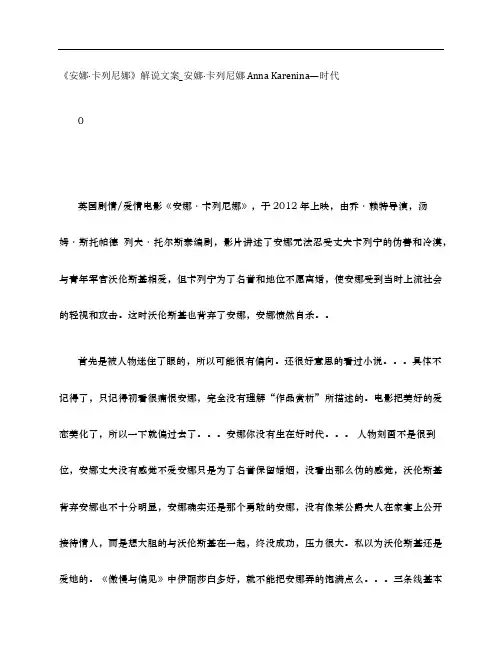
《安娜·卡列尼娜》解说文案_安娜·卡列尼娜 Anna Karenina—时代英国剧情/爱情电影《安娜·卡列尼娜》,于2012年上映,由乔·赖特导演,汤姆·斯托帕德列夫·托尔斯泰编剧,影片讲述了安娜无法忍受丈夫卡列宁的伪善和冷漠,与青年军官沃伦斯基相爱,但卡列宁为了名誉和地位不愿离婚,使安娜受到当时上流社会的轻视和攻击。
这时沃伦斯基也背弃了安娜,安娜愤然自杀。
首先是被人物迷住了眼的,所以可能很有偏向。
还很好意思的看过小说。
具体不记得了,只记得初看很痛恨安娜,完全没有理解“作品赏析”所描述的。
电影把美好的爱恋美化了,所以一下就偏过去了。
安娜你没有生在好时代。
人物刻画不是很到位,安娜丈夫没有感觉不爱安娜只是为了名誉保留婚姻,没看出那么伪的感觉,沃伦斯基背弃安娜也不十分明显,安娜确实还是那个勇敢的安娜,没有像某公爵夫人在家宴上公开接待情人,而是想大胆的与沃伦斯基在一起,终没成功,压力很大。
私以为沃伦斯基还是爱她的。
《傲慢与偏见》中伊丽莎白多好,就不能把安娜弄的饱满点么。
三条线基本不明显。
换景是舞台剧的形式的。
画面很美,音乐很适合~ 才知道乔·怀特擅长这种风格。
沃伦斯基安娜安娜与沃伦斯基卡列宁––––––––––-以下剧透––––––––––––––安娜去俄国帮助哥哥解决与嫂子之间问题的时候认识沃伦斯基,沃伦斯基爱上了安娜一路离开俄国追去安娜的地方,安娜鉴于家庭道德并没有接受。
在沃伦斯基的母亲知道后要调走他向安娜表达安娜接受了他。
安娜怀了沃伦斯基的孩子,卡列宁要求安娜不与沃伦斯基见面,维持婚姻。
而安娜带着她与沃伦斯基的孩子和沃伦斯基一起走了。
两人在一起后受上流社会排斥,压力很大。
安娜最后卧轨自杀了。
喜欢沃伦斯基的女孩和一直爱她的别人结婚生子了,卡列宁养大安娜生的两人孩子,沃伦斯基的和他自己的。
父子三人野外。
完。
物景为了截狗。
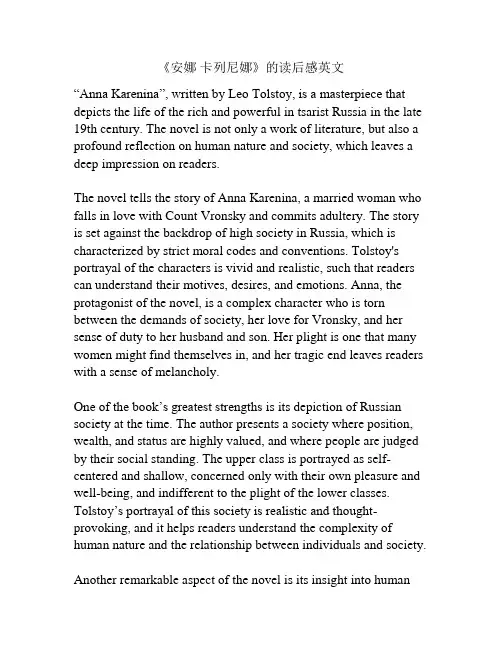
《安娜卡列尼娜》的读后感英文“Anna Karenina”, written by Leo Tolstoy, is a masterpiece that depicts the life of the rich and powerful in tsarist Russia in the late 19th century. The novel is not only a work of literature, but also a profound reflection on human nature and society, which leaves a deep impression on readers.The novel tells the story of Anna Karenina, a married woman who falls in love with Count Vronsky and commits adultery. The story is set against the backdrop of high society in Russia, which is characterized by strict moral codes and conventions. Tolstoy's portrayal of the characters is vivid and realistic, such that readers can understand their motives, desires, and emotions. Anna, the protagonist of the novel, is a complex character who is torn between the demands of society, her love for Vronsky, and her sense of duty to her husband and son. Her plight is one that many women might find themselves in, and her tragic end leaves readers with a sense of melancholy.One of the book’s greatest strengths is its depiction of Russian society at the time. The author presents a society where position, wealth, and status are highly valued, and where people are judged by their social standing. The upper class is portrayed as self-centered and shallow, concerned only with their own pleasure and well-being, and indifferent to the plight of the lower classes. Tolstoy’s portrayal of this society is realistic and thought-provoking, and it helps readers understand the complexity of human nature and the relationship between individuals and society. Another remarkable aspect of the novel is its insight into humannature. Tolstoy masterfully shows the conflicts that arise when different values and desires clash with each other. For example, Anna’s love for Vronsky and her sense of duty to her husband and son create a dilemma that plagues her throughout the novel. Similarly, the cultural idea of 'honor' places a heavy burden on the men in the novel, contributing to their behavior and the way they interact with others. These conflicts lead to the unavoidable conclusion that we are all human with flaws and weaknesses.Finally, the novel explores the theme of fate and free will. Anna is a victim of circumstances. Although she has free will to make the choices she desires, her fate becomes tied to events and decisions she had no control over. This brings up questions about whether we are free to make our own choices or if our lives are predetermined by fate. Tolstoy suggests that our outcome is a combination of the two.Overall, “Anna Karenina” is a novel that provides a deep insight into human nature and society. Tolstoy masterfully creates complex characters, vividly portrays the social structure of his time, and explores the themes of love, morality, and human nature. This novel is a masterpiece and I highly recommend it to anyone interested in literature and human nature.In addition to its exploration of human nature and society, “Anna Karenina” also offers a detailed depiction of the period in which it is set. The novel offers a glimpse into the political and social climate of late 19th century Russia, showcasing the rituals and habits of the aristocracy, their attitudes towards life, love, and death, and the challenges faced by women in a patriarchal society. Tolstoy’s attention to detail adds depth and richness to the narrative, makingit a compelling read for history enthusiasts.Furthermore, “Anna Karenina” has had a significant impact on literature and art since its publication. The novel’s structure and style are considered innovative for its time, with its use of various narrative techniques, multiple character perspectives, and its introspective approach to human consciousness. The book has inspired numerous adaptations, including stage plays, operas, films, and TV series. The story and characters continue to resonate with modern audiences, as seen by the many adaptations and references in popular culture.Finally, Tolstoy’s work has earned him a place among the Russian literary greats. His ability to delve into the complexities of the human psyche, society, and morality has made his novels timeless classics. “Anna Karenina” is a prime example of his mastery, showcasing his ability to weave together multiple themes and create memorable characters. As a result, readers continue to turn to Tolstoy’s works for insight into the human condition and the timeless struggle between fate and free will.Overall, “Anna Karenina” is a timeless masterpiece that continues to enthrall readers today. With its vivid portrayal of society, insightful exploration of human nature, and contributions to literature and art, it remains a must-read for anyone interested in understanding the complexities of life and society.。
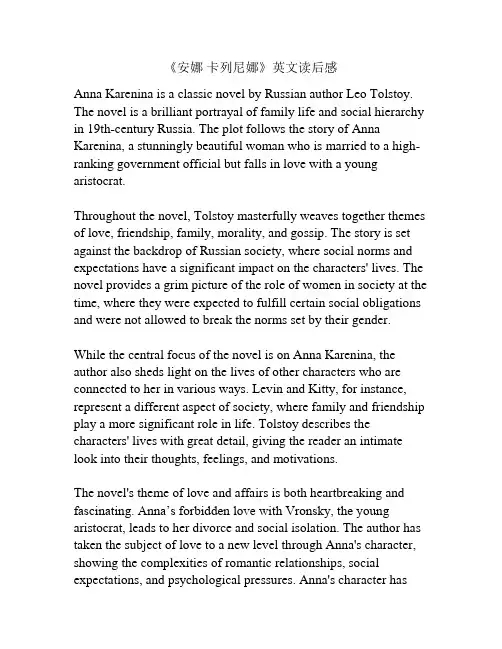
《安娜卡列尼娜》英文读后感Anna Karenina is a classic novel by Russian author Leo Tolstoy. The novel is a brilliant portrayal of family life and social hierarchy in 19th-century Russia. The plot follows the story of Anna Karenina, a stunningly beautiful woman who is married to a high-ranking government official but falls in love with a young aristocrat.Throughout the novel, Tolstoy masterfully weaves together themes of love, friendship, family, morality, and gossip. The story is set against the backdrop of Russian society, where social norms and expectations have a significant impact on the characters' lives. The novel provides a grim picture of the role of women in society at the time, where they were expected to fulfill certain social obligations and were not allowed to break the norms set by their gender.While the central focus of the novel is on Anna Karenina, the author also sheds light on the lives of other characters who are connected to her in various ways. Levin and Kitty, for instance, represent a different aspect of society, where family and friendship play a more significant role in life. Tolstoy describes the characters' lives with great detail, giving the reader an intimate look into their thoughts, feelings, and motivations.The novel's theme of love and affairs is both heartbreaking and fascinating. Anna’s forbidden love with Vronsky, the young aristocrat, leads to her divorce and social isolation. The author has taken the subject of love to a new level through Anna's character, showing the complexities of romantic relationships, social expectations, and psychological pressures. Anna's character hasbeen written in such a way that she is both admirable and flawed, making her human, and relatable.Moreover, the novel explores the double standards of Victorian society towards male and female adultery. Vronsky is looked upon as a charming man whereas, Anna is condemned by society. This highlights the unfair treatment of women in those times and the narrow-mindedness of society in judging people based on gender.The author also touches on the importance of religion and the search for the meaning of life. Through Levin’s character, Tolstoy explores the idea of spirituality and faith, portraying the protagonist's struggles to come to terms with his beliefs. Levin's story is insightful, providing a refreshing break from the tumultuous love story of Anna and Vronsky.In conclusion, Anna Karenina is a profound masterpiece, which successfully captures the essence of Russian society and the complexities of human relationships. Tolstoy's writing style is fluid and descriptive, drawing the reader into a world filled with love, longing, and tragedy. His portrayal of Anna Karenina is timeless and relevant, highlighting the timeless issues of gender, love, and morality. The novel's themes continue to resonate with readers, making it a timeless classic that should be read by all literature enthusiasts.。
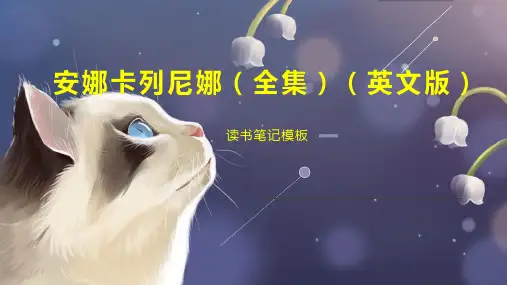
09.24.02.Anna.Karenina.1997.DVDRip.XviD-ABEZ IMDB评分:5.8/10 (388 votes)IMDB英文链接安娜卡列尼娜ANNA KARENINA美国华纳兄弟影片公司1997年4月4日出品制片人:布鲁斯·达维(Bruce Davey)。
导演:柏纳德罗斯(Bernard Rose)主演:苏菲玛索(Sophie Marceau)西恩·宾(Sean Bean)艾尔菲·摩里纳(Alfred Molina)莎丝琪·亚威克曼(Saskia Wickham)剧情:十九世纪俄罗斯的上流社会里,高层首长卡列宁之妻安娜(苏菲玛索饰)艳冠群芳,在火车上她邂逅了风流倜傥的伯爵渥伦斯基(西恩·宾饰)。
渥伦斯基的热情唤醒了安娜沉睡已久的爱情,二人产生了真爱,在当时社会强大的舆论压力下,不顾一切地私奔,他们的爱情悲剧就此展开。
虽然安娜勇敢地告诉自己的丈夫一切实情,希望能离婚,但看重社会地位的卡列宁(詹姆斯福克斯饰),难以忍受夺妻的耻辱,以安娜最心爱的儿子做威胁,拒绝和安娜离婚并逼她放弃儿子。
此刻,安娜已离家与渥伦斯基同居,怀了他的孩子,却不幸流产,得了后遗症,又对酒与药物有了依赖性,经过重重困难波折后,安娜的精神压力变得非常大。
后来,渥伦斯基承受不了社会压力开始对她表示冷淡,安娜付出了失去家庭、儿子和社会地位的高昂代价,而现在所谓真挚自由的爱情也开始要被遗弃,她内心无法获得满足和平衡。
最后安娜身着一袭黑天鹅绒长裙,在火车站的铁轨前,让呼啸而过的火车结束了自己无望的爱情和生命,这段为道德和世间所不容的婚外情最后的结果由安娜独立承担,留下了无限感伤。
剧中的苏菲·玛索:《安娜·卡列尼娜》作为俄国大文豪列夫·托尔斯泰的传世名作,曾五度被改编成电影。
葛丽泰·嘉宝和费雯丽都曾经出演过莎翁笔下这位悲剧女主角的形象,尤其是葛丽泰·嘉宝的安娜形象更深刻留在人们记忆中,这位好莱坞银幕“女神”创造的安娜形象成为不可逾越的世纪神话。
安娜卡列尼娜英文简介《安娜·卡列尼娜》,俄国作家列夫·托尔斯泰创作的长篇小说,讲述了贵族妇女安娜追求爱情幸福,下面是店铺为你整理的安娜卡列尼娜英文简介,希望对你有用!《安娜·卡列尼娜》简介"Anna Karenina" is a Russian writer Leo Tolstoy's creation of novels, but also its representative works.Works about the aristocratic women Anna pursuit of happiness, but in the hypocrisy of Callein, Warrensky's indifference and selfish face in front of badly beaten, eventually fell on the rail suicide, Chenchen station end. Manor Lord Levine against the private ownership of the land, resist the capitalist system, sympathize with the poor peasants, but can not get rid of aristocratic habits and fall into the contradiction can not be released. Contradictory period, contradictory system, contradictory characters, contradictory psychology, so that the book in the vortex of contradictions in the bumps. This novel is a portrayal of Russian society that is terrified by the old and new periods.The book through the heroine Anna's pursuit of love tragedy, and Levin in the rural crisis and the reform and exploration of these two clues, depicting the Russian from Moscow to other provinces of rural vast and colorful picture, has described more than 150 People, is a social encyclopedia of works.《安娜·卡列尼娜》内容简介Anna Karenina's brother, Obrensky's Duke, has five children and is still in love with the French family of female teachers, so he and his wife Doris fall out, Anna from Petersburg to Moscow to mediate in Moscow for Costa Rica , At the station met theyoung officer of Warrensky. Wollongsky graduated from the aristocratic military school, after the involvement in the Moscow social circles, with its elegant style got Dolly's sister Kitty's favor, but he only flirting with her, and no intention to marry her.And the love of Kitty's Constantine Levin came from the country to Moscow, he intended to marry Kitty. But Kitty, who had long been in the heart of Warrensky, rejected his proposal, and she was imagining a happy life with Warrensky's future. Warrensky is a physically strong man with a nice, beautiful and unusually quiet and decisive face, young and handsome and suave, handsome and compelling. His appearance and style, so many aristocratic lady attracted.When he saw Anna's moment, it was captured by Anna, who was very attentive to Anna at the dancers of the Grand Duke of the Scarlet Abbey. And Kitty carefully dressed to imagine the Wolonsky to formally propose to her, in the eyes of the Warrensky, Anna Karenina is so outstanding: "her wearing a simple black dress attitude is charming, Her round arm with a bracelet is charming, her lively, beautiful face is charming and amiable, at the ball ... ... "Kitty found that Wolensky and Anna were exceptionally affectionate, which made her feel depressed. Anna did not want to see Kitty's pain, comforting the brother-in-law, and then went back to Petersburg. Then Wolensky came to Petersburg and began a warm pursuit of Anna, who took part in all the dance and banquets that saw Anna, which caused the gossip of the upper class. At first, Anna has also been suppressed with their own feelings, and soon the warmth of Wolensky awakened Anna long sleepy love.Anna's husband, Alexander Callein, is not a prominent figure,but in the official field is a prominent character, is a "completely obsessed with fame" characters. He did not understand what was the love of love, he thought: his combination with Anna is God's will. He blamed his wife for failing to act, to pay attention to social opinion, to understand the religious significance of marriage, and the responsibility of children. He does not care that his wife and others are good, "but others noticed that he was disturbed."One day, Anna and her husband, Carlining, went to see a grand jockey meeting, where Warrensky fell from the horse, and Anna could not help but exclaimed, and Karen was thinking that Anna had a checkpoint and forced her to leave early. Anna can not tolerate her husband's hypocrisy and selfishness, uttered his own voice: "I love him ... ... I hate you ... ...".Because of the surprising generosity of Callein, Warrensky felt that he was so despicable and insignificant. Anna's love and his future are so slim, despair, shame, guilt so that he raised his pistol suicide, but did not die. The resurrection of Anna and Warrensky's love was even more hot, and Warrensky took Anna away from Petersburg and they traveled abroad.At the banquet of the Wolonsky, Levine and Kitty removed the gap and loved each other. Soon they were married, and after marriage they returned to the village of Levin, and Kitty was in charge of the housework, and Levin wrote a paper on agricultural reform, and they were very happy.Travel for three months, Anna felt very happy, but she was at the expense of honor and son. After returning home, she did not go home, but lived in the hotel, because of his son, in the son of Xie Liao Sha birthday that day, secretly to see him, innocent Xie Liao Sha left her mother, he said with tears "There is no better person than you."They returned to Petersburg, was cold, old relatives and friends refused to deal with Anna, make her feel humiliated and painful. Wollesky was re-entered the social circles of desire and pressure on public opinion overwhelmed, and Anna separated, try to avoid her alone, which makes Anna feel very sad, she asked: "We also love each other? Do not worry. "At a party, Anna was publicly humiliated by Mrs. Kartassov, and after returning to Warrensky, she complained that she should not listen to advice to attend the party. So they moved to the village of Wolonsky to live on the village. Warrensky wants Anna and Karening to divorce, but she is worried that her son will look down on her in the future. 3 months have passed, no news of divorce.Worensky is getting cold on Anna, and he often goes to the club and throws Anna a man at home. Anna asked Warrensky to say that if he does not love her again, please tell him honestly, Skye was greatly annoyed. Once, Wolensky went to work with his mother, and Anna asked his mother if he wanted to intercede for him. He wanted Anna not to slander his respected mother, and Anna recognized the hypocrisy of Warrensky because he did not love His mother.After Hurricane, Wolensky angrily left, she felt everything was over, Anna ready to take a train to find him, she imagined and his mother and his favorite lady talk, she recalled this life, understand their own Is an insulted, abandoned man, she went to the station, in the waiting room received a letter from the Warrensky, said he was 10 o'clock to come back, she was determined not to let Wolonsky torture her, played A desperate and determined revenge mentality, and finally Anna dressed in dressed in black velvet dress, in front of the railway station rail,let the roaring past the end of their own hope that love and life, this section for the moral and the world can not The final result of the extramarital affair by Anna independent commitment, leaving the infinite sentimental.Karening took part in Anna's funeral and took Anna's daughter away. Warrensky was condemned by his conscience, and he volunteered to join the army in Serbia and Turkey, but he wanted to die.。
作文:《安娜·卡列尼娜的爱情悲剧》英文版本Anna Karenina's Tragedy of LoveAnna Karenina is one of the representative works of Russian writer Leo Tolstoy, depicting the various ugliness and moral decline of the upper class society in 19th century Russia, and showcasing Tolstoy's profound reflection on human nature through the tragic love story of the protagonist Anna Karenina.Anna Karenina is a beautiful and intelligent aristocratic woman, and her presence has captivated the entire social circle. However, Anna's marriage with her husband Karenin was full of contradictions and unhappiness. When she met the young and promising officer Zvilkov, the passion between the two quickly ignited, ultimately leading to their unfortunate ending.Anna's tragic love story stems from her pursuit of her true inner emotions, but she is bound by moral and religious norms. In a feudal society, marriage was considered the most sacred thing, while betrayal was an unforgivable crime. Anna was unable to overcome the pressure of social opinion and family when pursuing her love, and ultimately fell into a desperate situation.Anna Karenina's tragic love story reflects the various contradictions and injustices in Russian society at that time, revealing the constraints and harm of feudal moral concepts on individual freedom. The emergence of conflicts stems from conflicts between the needs of oneself and others, and ultimately leads to unfortunate outcomes.Through Anna Karenina's tragic love story, Tolstoy portrays the complexity of human nature and the insurmountable fate. He criticized the excessive interference of society in individual behavior and the shackles of moral norms, calling on people to cherish sincere emotions and pursue inner truth, and not be bound by social opinion and traditional values.In contemporary society, despite changes in values and moral concepts, people still face conflicts between their own needs and the expectations of others. Therefore, we can draw profound inspiration from Anna Karenina's tragic love story, truly cherish emotions and interpersonal relationships in life, not be influenced by external interference and constraints, and pursue inner truth and freedom.中文版本《安娜·卡列尼娜的爱情悲剧》《安娜·卡列尼娜》是俄国作家列夫·托尔斯泰的代表作之一,描写了19世纪俄国上层社会的种种丑恶和道德沦丧,并以主人公安娜·卡列尼娜的爱情悲剧展现出了托尔斯泰对人性的深刻思考。